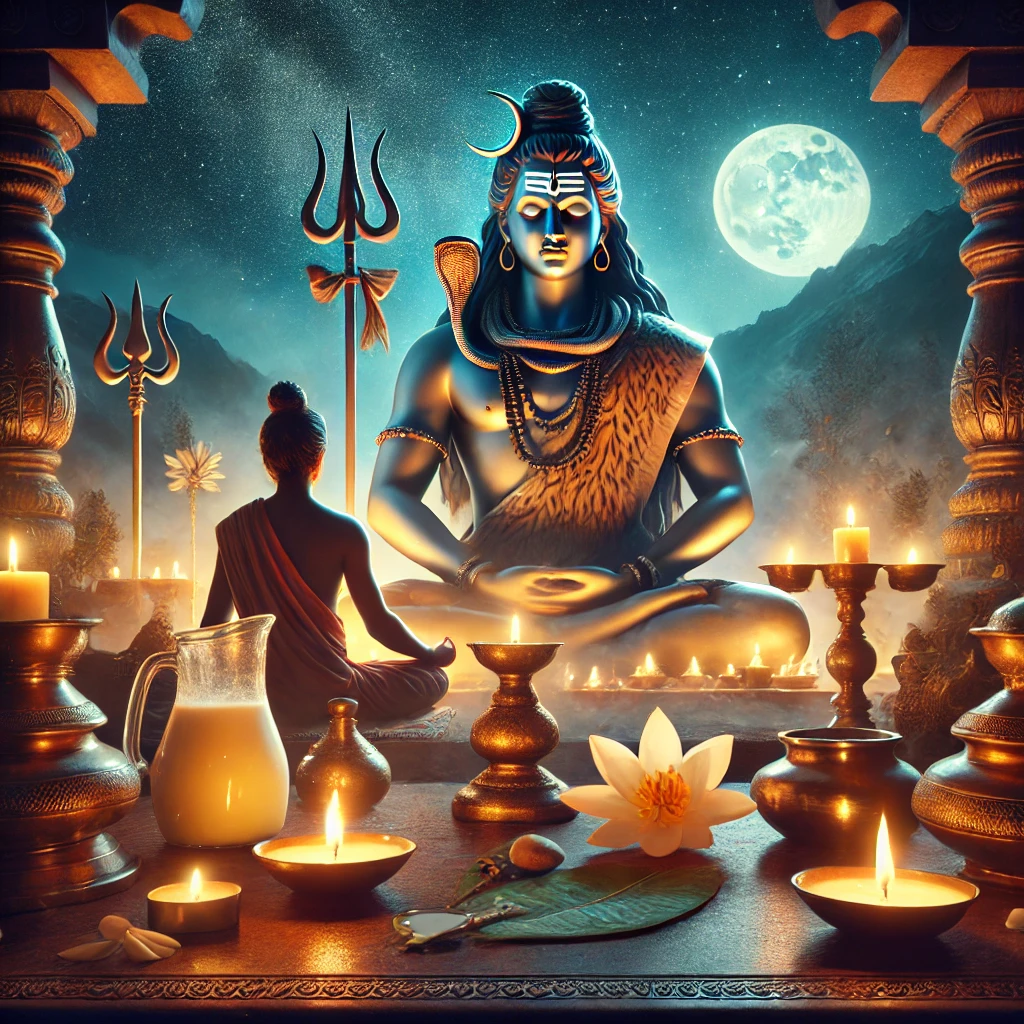Maha Shivaratri, one of the most sacred Hindu festivals, holds immense significance for devotees of Lord Shiva. But this year, Maha Shivaratri 2025 is even more special as it coincides with the grand Kumbh Mela—a rare celestial event that amplifies the spiritual energy of this sacred night. The Kumbh Mela, a massive gathering of saints, sages, and devotees at the banks of holy rivers, is believed to be the largest spiritual congregation on Earth. As millions take a holy dip in the Ganges, seeking purification and liberation, Maha Shivaratri adds another dimension of divine awakening, making this year’s celebration truly extraordinary.
This article will take you through:
✅ The history and mythology behind Maha Shivaratri
✅ Its spiritual significance and why it is celebrated at night
✅ How Maha Shivaratri is observed in different parts of India and the world
✅ The scientific benefits of fasting and meditation on this auspicious night
By the end, you will have a deep understanding of why Maha Shivaratri is much more than just a religious observance—it is a night of cosmic energy and self-discovery.
What is Maha Shivaratri?
Maha Shivaratri, meaning “The Great Night of Shiva,” is an annual Hindu festival dedicated to Lord Shiva, the supreme deity known as the Destroyer and Transformer in Hinduism. Unlike many Hindu festivals that are celebrated during the day with feasts and festivities, Maha Shivaratri is observed at night, with deep devotion, fasting, and meditation.
Why is Maha Shivaratri Celebrated?
This sacred night is believed to be the most powerful for spiritual growth, inner transformation, and seeking blessings from Lord Shiva. The festival represents:
- Victory of light over darkness – overcoming ignorance through knowledge.
- The merging of Shiva and Shakti (masculine and feminine energies).
- A night of cosmic awakening where devotees experience divine consciousness.
When is Maha Shivaratri Observed?
Maha Shivaratri is observed on the 14th night of the dark fortnight (Krishna Paksha) in the Hindu month of Phalguna or Magha, which usually falls in February or March in the Gregorian calendar.
This timing is considered extremely auspicious because it is believed that on this night:
✔️ The planetary positions help in spiritual elevation.
✔️ Cosmic energy is at its peak, making it an ideal time for meditation.
Hindus celebrate 12 Shivaratris every year, occurring on the 14th day of each lunar month. However, Maha Shivaratri is the most significant, attracting millions of devotees across India and worldwide.
The Mythological Significance of Maha Shivaratri
Maha Shivaratri is deeply rooted in Hindu mythology, with multiple fascinating legends explaining its significance. These stories highlight the divine nature of Lord Shiva and why this night is considered sacred.
1. The Marriage of Shiva and Parvati – The Divine Union
One of the most popular legends states that Maha Shivaratri marks the divine marriage of Lord Shiva and Goddess Parvati. According to Hindu scriptures:
- Goddess Parvati performed intense penance to win Lord Shiva’s love.
- Pleased with her devotion, Shiva agreed to marry her on this auspicious night.
- Their union represents the balance of masculine and feminine energies (Shiva & Shakti), symbolizing harmony, creation, and cosmic order.
- Devotees, especially unmarried women, fast and pray on this night to seek an ideal partner like Shiva.
2. The Samudra Manthan – Shiva Saves the Universe
Another significant legend is from the epic story of Samudra Manthan (Churning of the Ocean).
- During the churning of the ocean by Devas (gods) and Asuras (demons), a deadly poison called Halahala emerged.
- This poison was so powerful that it could destroy the entire universe.
- To save creation, Lord Shiva drank the poison and held it in his throat, turning it blue—earning him the name Neelkanth (The Blue-Throated One).
- Maha Shivaratri is believed to be the night when Shiva saved the world, making it a sacred time for offering gratitude and devotion.
3. Shiva’s Cosmic Dance (Tandava) – The Cycle of Creation and Destruction
According to another legend, Maha Shivaratri is the night when Lord Shiva performs the cosmic dance of destruction and creation—Tandava.
- This dance represents the continuous cycle of life, death, and rebirth.
- The vibrations from Shiva’s dance are believed to keep the universe in motion.
- Devotees stay awake all night to witness this divine moment in meditation.
Why These Legends Matter
Each of these legends highlights different aspects of Shiva’s divine power:
✔️ Shiva as the ideal husband (Marriage with Parvati).
✔️ Shiva as the savior of the world (Drinking the poison).
✔️ Shiva as the cosmic dancer, maintaining universal balance (Tandava).
These stories deepen the spiritual meaning of Maha Shivaratri, inspiring millions to seek inner strength, wisdom, and transformation.
The Spiritual Significance of Maha Shivaratri
Maha Shivaratri is not just a religious festival; it is a night of deep spiritual awakening and transformation. It holds immense significance for those seeking inner peace, self-discipline, and enlightenment. Unlike other Hindu festivals that celebrate prosperity and joy, Maha Shivaratri is about silence, introspection, and devotion.
1. A Night of Enlightenment and Self-Reflection
Hindu scriptures describe Maha Shivaratri as the most powerful night for spiritual growth. It is believed that on this night:
✔ Shiva’s energy is at its peak, allowing devotees to experience higher states of consciousness.
✔ Meditation and chanting help clear negative karma and bring inner peace.
✔ Staying awake symbolizes overcoming darkness (ignorance) with light (wisdom).
For yogis and seekers, this night is considered the best time for meditation and self-realization, as the mind is naturally calm and focused.
2. Maha Shivaratri and the Power of Fasting
Fasting on Maha Shivaratri is not just a religious ritual—it has deep scientific and spiritual benefits:
- Cleanses the body and mind, helping in detoxification.
- Boosts willpower and discipline, essential for spiritual progress.
- Enhances concentration and mental clarity, making meditation more effective.
Devotees observe different types of fasts:
- Nirjala Vrat (Complete fast without food and water).
- Phalahar Vrat (Eating only fruits and milk).
- Light fasting (Avoiding grains and spicy food, consuming simple meals).
3. Connection with Meditation and Cosmic Energy
The planetary alignment on Maha Shivaratri is believed to have a unique impact on human consciousness. According to yogic traditions:
- Spiritual energy flows upward, making it easier to experience deep meditation.
- Chanting “Om Namah Shivaya” creates powerful vibrations that align the mind and soul.
- The stillness of the night is perfect for self-reflection and enlightenment.
This is why devotees engage in “Jaagran” (staying awake all night), meditating on Lord Shiva to absorb divine energy.
4. The Symbolism of Lord Shiva in Spirituality
Lord Shiva is not just a deity; he represents the ultimate truth and universal consciousness. His attributes symbolize:
✔ The Third Eye – Awareness beyond the material world.
✔ The Crescent Moon – Control over time and emotions.
✔ The Serpent (Vasuki) – Mastery over fear and desires.
✔ The Trident (Trishul) – Balance of body, mind, and soul.
Maha Shivaratri is a reminder to embrace these qualities and seek inner strength, wisdom, and balance in life.
How is Maha Shivaratri Celebrated in India?
Maha Shivaratri is observed with deep devotion and strict discipline across India. Unlike other Hindu festivals filled with feasts and celebrations, this night is spent in prayer, fasting, and meditation. Devotees visit temples, chant Shiva mantras, and offer sacred items to Lord Shiva to seek his blessings.
1. Fasting & Devotion – A Test of Willpower
Fasting on Maha Shivaratri is believed to purify the mind and body, helping devotees focus entirely on spirituality. Different types of fasts include:
✅ Nirjala Vrat – Complete fast without food or water.
✅ Phalahar Vrat – Only fruits, milk, and nuts are consumed.
✅ Light Fasting – Simple meals without grains or spicy food.
Even those who cannot fast fully follow dietary restrictions, avoiding non-vegetarian food, garlic, onions, and alcohol.
2. Night-Long Worship & Jaagran (Staying Awake)
Devotees stay awake the entire night in a practice called Jaagran, meditating and praying to Lord Shiva. This is based on the belief that Shiva performed the cosmic dance (Tandava) on this night, filling the universe with divine energy.
Common practices during Jaagran include:
✔ Chanting “Om Namah Shivaya” for spiritual upliftment.
✔ Reading Shiva Purana and other holy scriptures.
✔ Listening to Shiva Bhajans and devotional songs.
3. Offerings to Lord Shiva – Symbolism & Significance
Lord Shiva is worshipped with special offerings, each carrying deep meaning:
- Milk & Water – Represents purity and devotion.
- Honey – Symbolizes a sweet, content life.
- Bilva (Bael) Leaves – Known for their cooling effect and considered Shiva’s favorite.
- Datura (Thorn Apple) & Bhang – Associated with Shiva’s ascetic lifestyle.
- Sandalwood Paste – Represents inner peace and calmness.
4. Visiting Shiva Temples – A Grand Spectacle
Shiva temples across India witness huge gatherings of devotees on Maha Shivaratri. Some of the most famous temples where grand celebrations take place include:
🏛 Kashi Vishwanath (Varanasi, Uttar Pradesh) – The spiritual heart of Shiva worship.
🏛 Somnath Temple (Gujarat) – One of the 12 Jyotirlingas, associated with divine energy.
🏛 Mahakaleshwar (Ujjain, Madhya Pradesh) – Famous for the Bhasma Aarti (offering of sacred ash).
🏛 Kedarnath Temple (Uttarakhand) – A pilgrimage site visited by thousands despite extreme weather.
🏛 Lingaraj Temple (Odisha) – Known for its massive night-long celebrations.
5. Regional Variations – Maha Shivaratri in Different States
Maha Shivaratri is celebrated with slight variations across India:
- In Tamil Nadu, devotees observe “Shivaratri Brahmotsavam” at temples like Chidambaram and Rameswaram.
- In Maharashtra, processions are held, and the festival is celebrated with bhajans and kirtans.
- In Himachal Pradesh and Kashmir, special fairs and cultural programs are organized.
- In West Bengal and Assam, Shiva Gajan is observed, where devotees undergo extreme penance to honor Shiva.
The essence of the festival, however, remains the same—worship, fasting, and spiritual awakening.
Maha Shivaratri in Other Countries
Maha Shivaratri is not confined to India; it is celebrated by Hindu communities around the world, from the temples of Nepal to the shores of Mauritius, showcasing the global reach and influence of Lord Shiva’s worship. Here are some notable places where Maha Shivaratri is celebrated with equal fervor and devotion:
1. Nepal – The Land of Lord Shiva
Nepal holds a special connection with Lord Shiva, as he is regarded as the patron deity of the country. In Kathmandu, the Pashupatinath Temple, one of the holiest temples for Hindus, becomes the center of the Maha Shivaratri celebrations.
- Devotees from across Nepal and India gather to offer prayers and perform rituals.
- The night-long vigil (Jaagran) is accompanied by chanting, prayers, and the performance of sacred dances.
- Thousands of Sadhus (holy men) also come to the Pashupatinath Temple, where they perform rituals and seek blessings from Lord Shiva.
2. Mauritius – A Celebration of Unity and Devotion
Mauritius, an island nation with a significant Hindu population, celebrates Maha Shivaratri with great zeal and enthusiasm.
- The Grand Bassin (Ganga Talao), a lake situated in the mountains, becomes the focal point of the celebrations.
- Devotees from all over the island gather here to take a holy dip in the lake, which is considered sacred, and offer prayers to Lord Shiva.
- Processions and devotional songs fill the streets, and the festival is a time for community bonding and cultural unity.
3. Indonesia – The Island of Bali and Shiva Worship
In Bali, Indonesia, where Hinduism is practiced by a majority of the population, Maha Shivaratri is celebrated with traditional rituals.
- The Pura Besakih Temple, Bali’s mother temple, hosts large-scale prayers and ceremonies.
- The Balinese people celebrate Maha Shivaratri with sacrifices, offerings, and prayers to Lord Shiva, asking for his protection and blessings for prosperity.
- Cultural performances and dances are a part of the celebration, bringing together the island’s Hindu traditions and modern rituals.
4. Trinidad and Tobago – A Blend of Faith and Culture
In countries like Trinidad and Tobago, where a large number of people of Indian descent reside, Maha Shivaratri is celebrated with passion.
- Shiva temples across the Caribbean are packed with devotees, and processions are organized in the streets, sometimes including dramatic re-enactments of stories from Hindu mythology.
- Traditional Hindu music and dance performances are common, and communities come together to celebrate the festival as a unifying force that transcends generations.
5. Other Countries Celebrating Maha Shivaratri
Maha Shivaratri is also observed in several other countries, including Fiji, Guyana, South Africa, and the United States.
- In the U.S., Hindu temples across various states, especially in New Jersey, California, and Texas, host large celebrations, inviting people from all walks of life to participate in the prayer and fasting rituals.
- In Fiji, where a large Hindu community exists, the temples come alive with devotional music and prayers dedicated to Lord Shiva.
The global celebrations of Maha Shivaratri show that this night is not just a Hindu observance but a global event that connects millions of people from different cultural backgrounds in devotion to Lord Shiva.
Maha Shivaratri and Science – The Connection
While Maha Shivaratri is deeply rooted in spirituality and mythology, there are aspects of the festival that align with scientific principles of health, well-being, and energy. Observing this sacred night through fasting, meditation, and devotion may have significant benefits for both body and mind. Let’s explore some scientific connections behind Maha Shivaratri that go beyond the realm of belief.
1. The Power of Fasting – Detoxification and Health Benefits
Fasting is a central aspect of Maha Shivaratri, with many devotees abstaining from food and water to purify their body and mind. Scientifically, fasting can offer several health benefits:
- Detoxification – Fasting allows the body to detoxify and cleanse itself by allowing it to rest from digestion, promoting the elimination of toxins.
- Improved Digestion – Extended fasting periods help reset the digestive system, improving metabolism and digestive efficiency.
- Cellular Repair and Longevity – Fasting triggers autophagy, a process where the body repairs damaged cells and promotes cell regeneration. This process is believed to help increase lifespan and prevent various diseases.
- Increased Mental Clarity – Abstaining from food can lead to enhanced concentration and focus, which aids in meditation and spiritual practices during Shivaratri.
Fasting on Maha Shivaratri can be seen as a way to purify the body while focusing the mind on spiritual growth and self-reflection.
2. The Psychological Impact of Meditation and Prayer
Meditation is an integral practice during Maha Shivaratri. The spiritual discipline of staying awake and meditating is believed to bring profound inner peace and awakening. From a scientific perspective, meditation has been shown to:
- Reduce Stress and Anxiety – Meditation has a direct effect on the nervous system, helping lower stress hormones like cortisol and promoting relaxation.
- Enhance Emotional Well-being – Regular meditation helps in reducing negative emotions, making the practitioner more compassionate and empathetic.
- Improve Focus and Concentration – As devotees meditate on Lord Shiva’s form and chant mantras like “Om Namah Shivaya,” their mental clarity improves, leading to greater focus and attention in everyday tasks.
- Balance Brainwaves – Scientific studies have shown that deep meditation can lead to the generation of alpha and theta brainwaves, which promote a calm and peaceful state of mind.
The night-long meditation on Maha Shivaratri enhances spiritual well-being, but it also has tangible psychological benefits for individuals seeking mental clarity and balance.
3. Energy and Vibrational Frequencies – Aligning with Cosmic Forces
Maha Shivaratri is believed to be a night when the cosmic energy is at its peak. The planetary alignment on this day is thought to enhance spiritual vibrations, providing a unique opportunity for devotees to align their inner energies with the universe. From a scientific viewpoint, everything in the universe—whether it be physical objects or energy fields—has a vibrational frequency.
- Chanting “Om Namah Shivaya” and other sacred mantras creates sound vibrations that can affect the body’s energy fields, helping to elevate the practitioner’s state of consciousness.
- Quantum physics has shown that human beings are influenced by the frequencies of their surroundings. Thus, chanting, meditation, and prayer on this night can increase a person’s vibrational energy, leading to spiritual and emotional growth.
The alignment of cosmic energies during Maha Shivaratri may provide a unique opportunity for deep meditation and connection to the divine, while the practice of chanting and offering devotion can bring about a higher state of being.
4. The Role of the Third Eye – Activation of Higher Consciousness
In many spiritual traditions, including Hinduism, the third eye is considered the seat of higher wisdom and intuition. Lord Shiva, often depicted with a third eye, represents awareness beyond the material world.
- Scientifically, the pineal gland, located in the center of the brain, is often associated with the third eye and is responsible for regulating melatonin and serotonin, which influence sleep patterns and mood.
- The practice of meditation on Maha Shivaratri may help activate the pineal gland, improving mental clarity, and fostering higher consciousness.
By meditating on Shiva’s third eye, devotees aim to unlock their hidden potential and expand their awareness, ultimately leading to spiritual enlightenment.
Conclusion – The Cosmic Awakening of Maha Shivaratri
Maha Shivaratri is much more than just a religious observance; it is a cosmic event that offers profound opportunities for spiritual awakening, self-realization, and inner peace. Whether you are a devotee seeking Lord Shiva’s blessings or someone curious about the deeper meanings of this sacred night, Maha Shivaratri holds universal significance that transcends cultural and geographical boundaries.
1. A Time for Reflection and Inner Transformation
This night invites every individual to pause, reflect, and reconnect with their inner self. Through fasting, meditation, and prayer, devotees purify their minds and bodies, shedding the burdens of daily life and embracing higher spiritual realms. Staying awake during the night symbolizes the overcoming of ignorance, transforming the darkness of the mind into the light of knowledge and awareness.
2. Celebrating Shiva’s Presence in Everyday Life
Lord Shiva is not only a deity worshipped in temples; he represents the cosmic forces that govern the universe. From the cycle of life and death to the forces of creation and destruction, Shiva embodies the eternal balance of opposites. By celebrating Maha Shivaratri, individuals acknowledge Shiva’s presence in their daily lives, realizing that the divine is present in all aspects of existence—from the simplest to the most complex.
3. The Global Unity of Maha Shivaratri
From the streets of Varanasi to the mountains of Nepal, from the shores of Mauritius to the islands of Bali, Maha Shivaratri brings people together across the world in a shared expression of devotion. The festival is a reminder that no matter where we come from or what our cultural backgrounds may be, we all share a common thread—our connection to the divine and to one another.
4. The Scientific and Spiritual Harmony
The combination of spiritual practices like meditation, chanting, and fasting, with their scientifically backed health benefits, creates a powerful synergy that promotes holistic well-being. Maha Shivaratri serves as a reminder that science and spirituality are not mutually exclusive but rather work together to elevate human consciousness. The cosmic alignment on this sacred night enhances the possibilities for transcendence and transformation, offering all of us an opportunity to awaken to our true selves.
5. The Path to Inner Peace and Liberation
Ultimately, Maha Shivaratri is a journey inward—a quest for inner peace, liberation from ignorance, and alignment with higher spiritual truths. As we embrace Lord Shiva’s teachings, we learn to overcome obstacles, find balance in our lives, and seek a path of self-awareness and wisdom. The lessons of Maha Shivaratri—discipline, devotion, and self-reflection—are timeless and offer guidance for every seeker on their spiritual journey.



